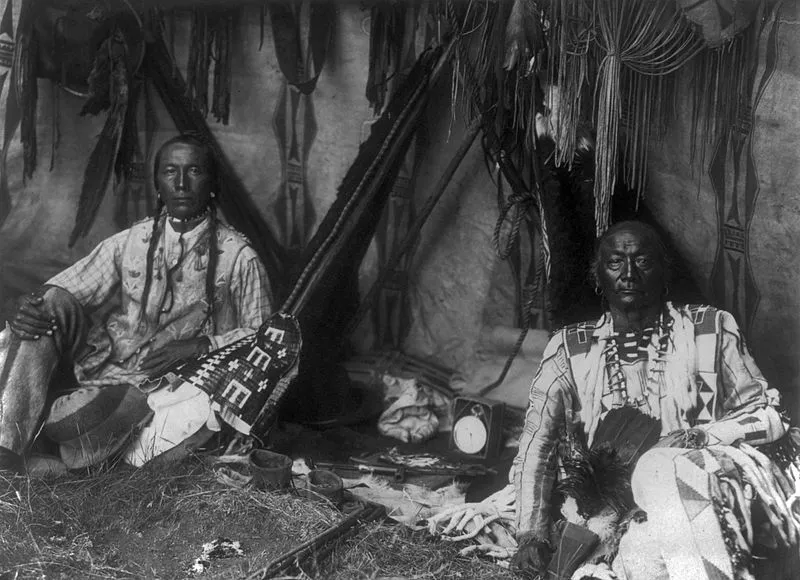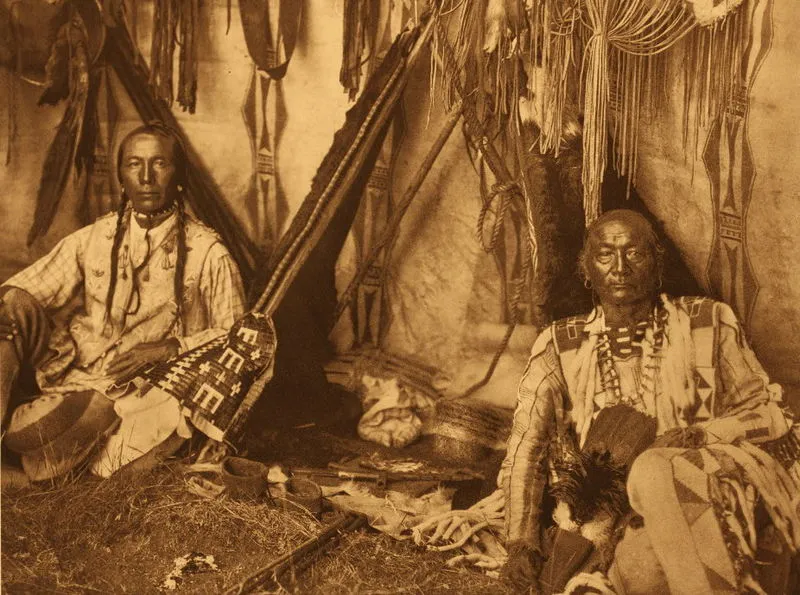Which of the Following Best Describes Edward S Curtis' Photography of Native Americans
/https://tf-cmsv2-smithsonianmag-media.s3.amazonaws.com/filer/2c/6c/2c6cc1e6-5e9d-44b9-98e1-da9706335382/canyon_de_chelly_navajo.jpg)
Year afterward year, he packed his photographic camera and supplies—everything he'd need for months—and traveled by pes and by equus caballus deep into the Indian territories. At the beginning of the 20th century, Edward S. Curtis worked in the belief that he was in a desperate race against fourth dimension to certificate, with film, audio and scholarship, the Due north American Indian earlier white expansion and the federal authorities destroyed what remained of their natives' style of life. For thirty years, with the backing of men like J. Pierpont Morgan and onetime president Theodore Roosevelt, just at great expense to his family life and his health, Curtis lived among dozens of native tribes, devoting his life to his calling until he produced a definitive and unparalleled piece of work, The North American Indian. The New York Herald hailed as "the most ambitious enterprise in publishing since the production of the Rex James Bible."
/https://tf-cmsv2-smithsonianmag-media.s3.amazonaws.com/filer/40/15/4015afac-66cc-48bf-acc4-4f9f258d7c34/ecurtis.jpg)
Built-in in Wisconsin in 1868, Edward Sheriff Curtis took to photography at an early age. By age 17, he was an apprentice at a studio in St. Paul, Minnesota, and his life seemed to be taking a familiar class for a young man with a marketable trade, until the Curtis family packed up and moved west, eventually settling in Seattle. There, Curtis married 18-yr-old Clara Phillips, purchased his own camera and a share in a local photography studio, and in 1893, the young couple welcomed a son, Harold—the first of their four children.
The young family lived above the thriving Curtis Studio, which attracted society ladies who wanted their portraits taken past the handsome, athletic young man who made them expect both glamorous and sophisticated. And it was in Seattle in 1895 where Curtis did his first portrait of a Native American—that of Princess Angeline, the eldest girl of Master Sealth of the Duwamish tribe. He paid her a dollar for each pose and noted, "This seemed to delight her greatly, and with hands and jargon she indicated that she preferred to spend her fourth dimension having pictures made than in digging clams."
Even so it was a take a chance meeting in 1898 that set Curtis on the path away from his studio and his family unit. He was photographing Mt. Rainier when he came upon a group of prominent scientists who'd become lost; amid the group was the anthropologist George Bird Grinnell, an practiced on Native American cultures. Curtis chop-chop befriended him, and the relationship led to the immature lensman's appointment every bit official lensman for the Harriman Alaska Expedition of 1899, led by the railroad magnate Edward H. Harriman and including included the naturalist John Muir and the zoologist C. Hart Merriam. For 2 months, Curtis accompanied ii dozen scientists, photographing everything from glaciers to Eskimo settlements. When Grinnell asked him to come on a visit to the Piegan Blackfeet in Montana the post-obit twelvemonth, Curtis did not hesitate.
It was in Montana, nether Grinnell's tutelage, that Curtis became securely moved by what he called the "primitive customs and traditions" of the Piegan people, including the "mystifying" Sun Dance he had witnessed. "It was at the start of my concerted attempt to learn about the Plains Indians and to photograph their lives," Curtis wrote, "and I was intensely afflicted." When he returned to Seattle, he mounted popular exhibitions of his Native American work, publishing magazine manufactures and then lecturing across the land. His photographs became known for their sheer dazzler. President Theodore Roosevelt commissioned Curtis to photograph his girl's wedding and to do some Roosevelt family portraits.
But Curtis was burning to return to the West and seek out more Native Americans to document. He found a lensman to manage his studio in Seattle, but more of import, he found a financial backer with the funds for a project of the calibration he had in mind. In 1906 he boldly approached J.P. Morgan, who quickly dismissed him with a note that read, "Mr. Curtis, at that place are many demands on me for financial assistance. I will exist unable to assistance you." But Curtis persisted, and Morgan was ultimately awed by the photographer's work. "Mr. Curtis," Morgan wrote after seeing his images, "I want to see these photographs in books—the most beautiful set of books ever published."
Morgan agreed to sponsor Curtis, paying out $75,000 over five years in exchange for 25 sets of volumes and 500 original prints. It was enough for Curtis to acquire the necessary equipment and hire interpreters and researchers. With a trail wagon and assistants traveling ahead to arrange visits, Edward Curtis set out on a journeying that would see him photograph the near of import Native Americans of the fourth dimension, including Geronimo, Red Deject, Medicine Crow and Chief Joseph.
The trips were non without peril—impassable roads, disease and mechanical failures; Arctic gales and the stifling heat of the Mohave Desert; encounters with suspicious and "unfriendly warriors." But Curtis managed to endear himself to the people with whom he stayed. He worked under the premise, he subsequently said, of "We, non you. In other words, I worked with them, not at them."

On wax cylinders, his crew nerveless more than ten,000 recordings of songs, music and speech in more than than eighty tribes, most with their own language. To the amusement of tribal elders, and sometimes for a fee, Curtis was given permission to organize reenactments of battles and traditional ceremonies amongst the Indians, and he documented them with his hulking 14-inch-by-17-inch view camera, which produced glass-plate negatives that yielded the crisp, detailed and gorgeous aureate-tone prints he was noted for. The Native Americans came to trust him and ultimately named him "Shadow Catcher," but Curtis would later note that, given his grueling travel and work, he should take been known as "The Man Who Never Took Time to Play."
But as Curtis began to produce book later volume of The North American Indian, to loftier acclaim, J.P. Morgan died unexpectedly in Egypt in 1913. J.P. Morgan Jr. contributed to Curtis's work, just in much smaller sums, and the lensman was forced to abandon his field work for lack of funding. His family life began to endure—something Curtis tried to rectify on occasion by bringing Clara and their children forth on his travels. Simply when his son, Harold well-nigh died of typhoid in Montana, his wife vowed never to travel with him over again. In 1916, she filed for divorce, and in a biting settlement was awarded the Curtis family habitation and the studio. Rather than let his ex-wife to profit from his Native American work, Edward and his girl Beth made copies of sure drinking glass plate negatives, and then destroyed the originals.
While the onset of Globe War I coincided with a diminishing involvement in Native American culture, Curtis scraped together plenty funding in an endeavour to strike it big with a motion motion-picture show, In the Country of the Head-Hunters, for which he paid Kwakiutl men on Vancouver Island to replicate the appearance of their forefathers by shaving off facial pilus and donning wigs and fake nose rings. The picture show had some critical success simply flopped financially, and Curtis lost his $75,000 investment.

He took work in Hollywood, where his friend Cecil B. DeMille hired him for camerawork on films such as The Ten Commandments. Curtis sold the rights to his movie to the American Museum of Natural History for a mere $i,500 and worked out a deal that immune him to return to his field work—by relinquishing his copyright on the images for The North American Indian to the Morgan Company.
The tribes Curtis visited in the late 1920s, he was alarmed to notice, had been decimated by relocation and assimilation. He constitute it more than difficult than ever to create the kinds of photographs he had in the past, and the public had long ceased caring nigh Native American culture. When he returned to Seattle, his ex-wife had him arrested for failing to pay alimony and child back up, and the stock market crash of 1929 made it nigh impossible for him to sell any of his work.
By 1930, Edward Curtis had published, to barely whatever fanfare, the last of his planned 20-volume fix of The N American Indian, after taking more than 40,000 pictures over 30 years. Still he was ruined, and he suffered a complete mental and physical breakdown, requiring hospitalization in Colorado. The Morgan Company sold 19 complete sets ofThe North American Indian, along with thousands of prints and copper plates, to Charles Lauriat Books of Boston, Massachusetts for just $i,000 and a percentage of time to come royalties.
One time Curtis sufficiently recovered his mental wellness, he tried to write his memoirs, but never saw them published. He died of a heart attack in California in 1952 at the age of 84. A small obituary in the New York Times noted his enquiry "compiling Indian history" under the patronage of J.P. Morgan and closed with the sentence, "Mr. Curtis was also widely known as a photographer."
The photographs of Edward Curtis stand for ethics and imagery designed to create a timeless vision of Native American culture at a time when modern amenities and American expansion had already irrevocably altered the Indian fashion of life. Past the time Curtis had arrived in various tribal territories, the U.South. authorities had forced Indian children into boarding schools, banned them from speaking in their native tongues, and fabricated them cut their hair. This was not what Curtis chose to document, and he went to great pains to create images of Native Americans posing in traditional clothing they had long since put away, in scenes that were sometimes later retouched past Curtis and his assistants to eliminate any modern artifacts, such as the presence of a clock in his image,In a Piegan Club.
Some critics have accused him of photographic fakery—of advancing his career past ignoring the plight and torment of his subjects. Others laud him, noting that he was, according to the Bruce Kapson Gallery, which represents Curtis's work, "able to convey a dignity, universal humanity and majesty that transcend literally all other piece of work ever done on the subject." It is estimated that producing The North American Indian today would cost more than $35 million.
"When judged past the standards of his time," Laurie Lawlor wrote in her book, Shadow Catcher: The Life and Work of Edward S. Curtis, "Curtis was far alee of his contemporaries in sensitivity, tolerance and openness to Native American cultures and ways of thinking. He sought to observe and sympathize past going directly into the field."
Sources
Books: Laurie Lawlor, Shadow Catcher: The Life and Work of Edward Southward. Curtis, Bison Books, 2005. Mick Gidley, Edward S. Curtis and the North American Indian, Incorporated, Cambridge University Press, 2000.
Manufactures: "Edward Curtis: Pictorialist and Ethnographic Adventurist," by Gerald Vizener, Essay based on author'due south presentation at an Edward Curtis seminar at the Claremont Graduate University, Oct 6-7, 2000. http://memory.loc.gov/ammem/award98/ienhtml/essay3.html "Edward Curtis: Shadow Catcher," by George Horse Capture, American Masters, April 23, 2001. http://www.pbs.org/wnet/americanmasters/episodes/edward-curtis/shadow-catcher/568/ "The Impoerfect Eye of Edward Curtis," by Pedro Ponce, Humanities, May/June 2000, Book 21/Number three. http://www.neh.gov/news/humanities/2000-05/curtis.html "Frontier Photographer Edward South. Curtis," A Smithsonian Establishment Libraries Exhibition. http://world wide web.sil.si.edu/Exhibitions/Curtis/index.htm "Selling the North American Indian: The Piece of work of Edward Curtis," Created by Valerie Daniels, June 2002, http://xroads.virginia.edu/~ma02/daniels/curtis/promoting.html "Edward S. Curtis and The North American Indian: A detailed chronological biography," Eric J. Keller/Soulcatcher Studio, http://www.soulcatcherstudio.com/artists/curtis_cron.html "Edward S. Curtis (1868-1952) and The Due north American Indian," by Mick Gidley, Essay from The North American Indian, The Vanishing Race: Selections from Edward S. Curtis' The Due north American Indian," (Newton Abbot: David and Charles, 1976 New York: Taplinger, 1977.) http://memory.loc.gov/ammem/award98/ienhtml/essay1.html
0 Response to "Which of the Following Best Describes Edward S Curtis' Photography of Native Americans"
Post a Comment